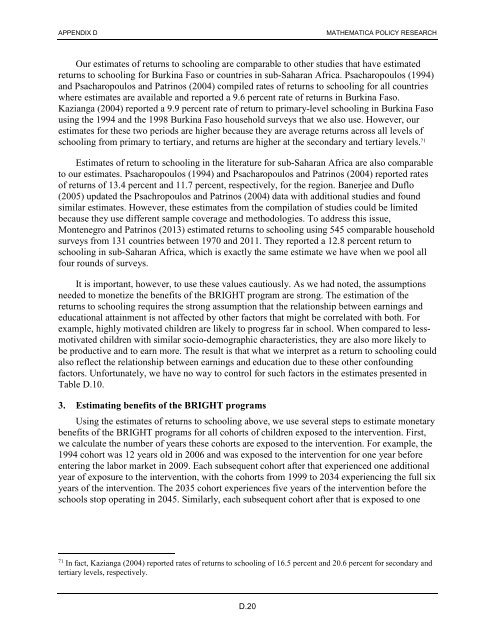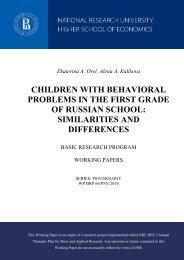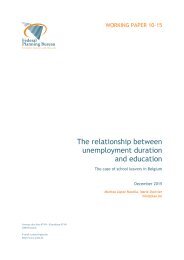Ten-Year Impacts of Burkina Faso’s BRIGHT Program
n?u=RePEc:mpr:mprres:2ecdd42bb503422b802ce20da2bf64b7&r=edu
n?u=RePEc:mpr:mprres:2ecdd42bb503422b802ce20da2bf64b7&r=edu
Create successful ePaper yourself
Turn your PDF publications into a flip-book with our unique Google optimized e-Paper software.
APPENDIX D<br />
MATHEMATICA POLICY RESEARCH<br />
Our estimates <strong>of</strong> returns to schooling are comparable to other studies that have estimated<br />
returns to schooling for <strong>Burkina</strong> Faso or countries in sub-Saharan Africa. Psacharopoulos (1994)<br />
and Psacharopoulos and Patrinos (2004) compiled rates <strong>of</strong> returns to schooling for all countries<br />
where estimates are available and reported a 9.6 percent rate <strong>of</strong> returns in <strong>Burkina</strong> Faso.<br />
Kazianga (2004) reported a 9.9 percent rate <strong>of</strong> return to primary-level schooling in <strong>Burkina</strong> Faso<br />
using the 1994 and the 1998 <strong>Burkina</strong> Faso household surveys that we also use. However, our<br />
estimates for these two periods are higher because they are average returns across all levels <strong>of</strong><br />
schooling from primary to tertiary, and returns are higher at the secondary and tertiary levels. 71<br />
Estimates <strong>of</strong> return to schooling in the literature for sub-Saharan Africa are also comparable<br />
to our estimates. Psacharopoulos (1994) and Psacharopoulos and Patrinos (2004) reported rates<br />
<strong>of</strong> returns <strong>of</strong> 13.4 percent and 11.7 percent, respectively, for the region. Banerjee and Duflo<br />
(2005) updated the Psachropoulos and Patrinos (2004) data with additional studies and found<br />
similar estimates. However, these estimates from the compilation <strong>of</strong> studies could be limited<br />
because they use different sample coverage and methodologies. To address this issue,<br />
Montenegro and Patrinos (2013) estimated returns to schooling using 545 comparable household<br />
surveys from 131 countries between 1970 and 2011. They reported a 12.8 percent return to<br />
schooling in sub-Saharan Africa, which is exactly the same estimate we have when we pool all<br />
four rounds <strong>of</strong> surveys.<br />
It is important, however, to use these values cautiously. As we had noted, the assumptions<br />
needed to monetize the benefits <strong>of</strong> the <strong>BRIGHT</strong> program are strong. The estimation <strong>of</strong> the<br />
returns to schooling requires the strong assumption that the relationship between earnings and<br />
educational attainment is not affected by other factors that might be correlated with both. For<br />
example, highly motivated children are likely to progress far in school. When compared to lessmotivated<br />
children with similar socio-demographic characteristics, they are also more likely to<br />
be productive and to earn more. The result is that what we interpret as a return to schooling could<br />
also reflect the relationship between earnings and education due to these other confounding<br />
factors. Unfortunately, we have no way to control for such factors in the estimates presented in<br />
Table D.10.<br />
3. Estimating benefits <strong>of</strong> the <strong>BRIGHT</strong> programs<br />
Using the estimates <strong>of</strong> returns to schooling above, we use several steps to estimate monetary<br />
benefits <strong>of</strong> the <strong>BRIGHT</strong> programs for all cohorts <strong>of</strong> children exposed to the intervention. First,<br />
we calculate the number <strong>of</strong> years these cohorts are exposed to the intervention. For example, the<br />
1994 cohort was 12 years old in 2006 and was exposed to the intervention for one year before<br />
entering the labor market in 2009. Each subsequent cohort after that experienced one additional<br />
year <strong>of</strong> exposure to the intervention, with the cohorts from 1999 to 2034 experiencing the full six<br />
years <strong>of</strong> the intervention. The 2035 cohort experiences five years <strong>of</strong> the intervention before the<br />
schools stop operating in 2045. Similarly, each subsequent cohort after that is exposed to one<br />
71<br />
In fact, Kazianga (2004) reported rates <strong>of</strong> returns to schooling <strong>of</strong> 16.5 percent and 20.6 percent for secondary and<br />
tertiary levels, respectively.<br />
D.20







